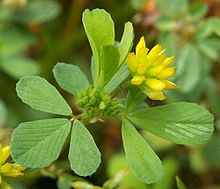Trifolium dubium
| Trifolium dubium | |
|---|---|

| |
| Scientific classification | |
| Kingdom: | Plantae |
| Clade: | Tracheophytes |
| Clade: | Angiosperms |
| Clade: | Eudicots |
| Clade: | Rosids |
| Order: | Fabales |
| Family: | Fabaceae |
| Subfamily: | Faboideae |
| Genus: | Trifolium |
| Species: | T. dubium
|
| Binomial name | |
| Trifolium dubium | |
| Synonyms[1] | |
| |
Trifolium dubium, the lesser trefoil,[2] suckling clover,[3] little hop clover or lesser hop trefoil, is a flowering plant in the pea and clover family Fabaceae. This species is generally accepted as the primary plant to represent the traditional Irish shamrock.[4]
It is native to Europe, but can be found in many parts of the world as an introduced species.
It is probably an allotetraploid with 2n=32 that arose from the crossing of Trifolium campestre and T. micranthum.[5]
Gallery
[edit]Similar plants
[edit]Lesser hop trefoil, Trifolium dubium, may be confused with other plants that have three leaflets and small yellow flowers, such as large hop trefoil (T. aureum), hop trefoil (T. campestre), black medick (Medicago lupulina), and yellow woodsorrel (Oxalis stricta).
See also
[edit]References
[edit]- ^ "The Plant List: A Working List of All Plant Species". Retrieved 28 June 2015.
- ^ BSBI List 2007 (xls). Botanical Society of Britain and Ireland. Archived from the original (xls) on 2015-06-26. Retrieved 2014-10-17.
- ^ NRCS. "Trifolium dubium". PLANTS Database. United States Department of Agriculture (USDA). Retrieved 15 December 2015.
- ^ Cooper, P. Shamrock shortage in Ireland sparks St. Pat's fears. Irish Central.
- ^ Ansari, H. A., et al. (2008). Molecular and cytogenetic evidence for an allotetraploid origin of Trifolium dubium (Leguminosae). Chromosoma 117(2):159-67.
External links
[edit]





